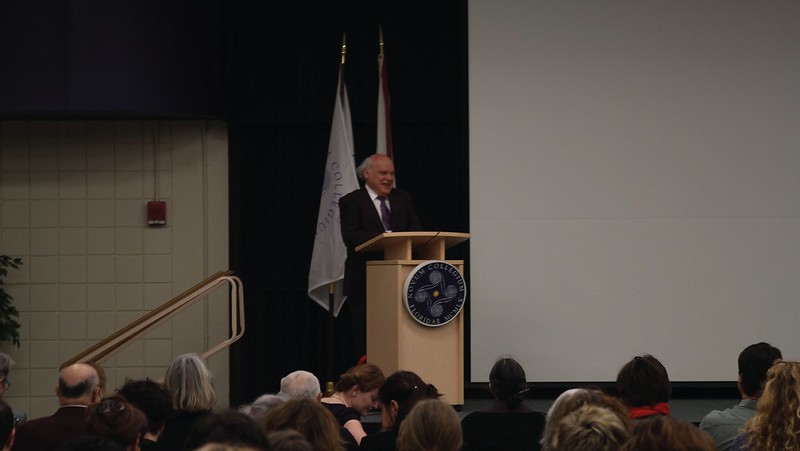
A large group of academics arrived at New College this past week, enlivening the insular campus atmosphere. The visitors were attendees of the 19th Biennial New College Conference on Medieval and Renaissance Studies, arriving for three days of presentations that filled up the Harry Sudakoff Center and College Hall.
“It originally started with Lee Snyder, who was originally the professor of Medieval and Renaissance history,” Professor of English Nova Myhill said. “He started it as this casual event where he was trying to get people from other Florida institutions together. When he started it Florida was a little bit of a backwater for this kind of thing.”
“But then it kept growing and he perceived that actually what was happening was that most people who came were not people from Florida,” Myhill continued. “They were people from really cold, unpleasant climates who found the idea of an academic conference in Florida in March very thrilling. I think we still have some of that.”
The conference was well-attended this year. In the Sudakoff Center, where rooms were temporarily rechristened with names like “Amberjack” and “Grouper,” academics displayed their work on topics ranging from homicide in early Renaissance Italy to Hildegard of Bingden’s practical advice for treating madness: wool caps, saunas and licorice. The papers that were presented had been selected from 228 submissions based on the quality and topic.
The biennial event was also agood opportunity for networking and meeting new people. Thesis student Nicholas Daugherty recalled meeting an influential historian at the 2012 conference.
“The coolest thing that happened last time is David Bebbington came,” Daugharty said. “He buddied up with me and Zack Lowe, who graduated now; he actually invited us out to dinner and offered to pay for everything.
“I’m so sad I couldn’t go,” Daugharty added. “It was spring break and I made commitments with family.”
Beyond the scholarly and social activities in Sudakoff, attendees took time for coffee and lunch. Some of them took time for a free tour of the Ringling Museum on Friday afternoon. Managing so many visitors had the potential for mistakes, but both the staff and organizers of the conference are used to the process. Division of labor is important to ensuring that everything gets taken care of.
“In 2006 Professor Beneš and I took it over,” Myhill explained. “When Professor Snyder did it, he really ran it by himself with an enormous amount of assistance, especially from the Social Science staff. And one thing that Professor Beneš and I both saw is that for one person, it is just an insane amount of work.”
“Obviously, anything that is programmatic and important we’re both involved and all the rest of the program committee is involved,” Myhill concluded. “But so much of this is just logistics, and we’ve gotten pretty good at farming that out over the years so all of us are working – Professor Rohrbacher is doing all the registration packets and Professor McCarthy is helping as well.”
Thesis student Alan Sachnowski, who was busy setting up the conference halls for Campus Space Scheduling, agreed that the event was exceptional.
“This is one of the biggest setups we have to do all year, even in terms of conferences,” Sachnowski explained. ”We had to use all 450 chairs.”
“An event this big doesn’t happen very often,” Sachnowski continued. “Even for orientation week, the other biggest setup we only have to put 300 or 400 chairs in the auditorium.”
The event also marked the beginning of a new tradition in memory of the founder Lee Snyder – the inaugural Snyder Prize, which recognizes the most outstanding paper presented by a junior scholar at the conference. This year the prize was awarded to Katarzyna Lecky for her paper “Romancing the Map of the Faerie in The Castle of Busyrane”, which she presented on the last day of the conference.
